________________
No. 8 ] BOBBILI PLATES OF CHANDAVARMAN, KING OF KALINGA; YEAR 4 33
V. 4. In the pious, prominent, farfamed, pure (and) virtuous family, called Dhusara, there was the celebrated Yasovardhana, whose son was Rama, the foremost banker, free of all blemishes, strong-armed (and), true to his word, from whom in turn came his son, the banker Mandana.
V. 5. And in the spotless, glorious, rich, liberal (and) chaste family, called Dharkata, whose wealth constantly vied with that of (the god) Indra, there was a banker, Mandana by name, who, while attaining to (the acme of) prosperity, out of respect, highly adorned his own community, (and) from whom was (born) the banker Madvana.
V. 6. Again, his son was the banker Garga, pious, noble, modest (and) always pleasant-looking. V. 7. The pre-eminent banker, called Mandana, acquired immense wealth and so did also the one named Garga, both of whom, showing great compassion towards all beings, carried bankership to perfection.
V. 8. Likewise there was also a merchant, (called) Bhaṭṭiyaka, born of the (same) Dharkata family. He, too, had a son, (named) Vardhana, who was prudent (and) whose good qualities were well-known.
V. 9. He had two sons, Gapaditya and Devalla by name, who were magnanimous, flawless (and) endowed with truthfulness, honesty and straightforwardness.
V. 10. Similarly there was also a merchant, (called) Siva, Tatta's son, who had his senses. controlled. And there was (another, named) Sankara Vishnuvāka's son, who was honest.
V. 11. And then there was Adityavardhana's son, the wise Maṇḍubāka. There was Vōdda's son, called Adityanaga who was very energetic.
V. 12. There was Naddhaka's son, called Bhadra who was the best among the intellectual. Likewise there was Jeulla's son, Udyōtana by name.
V. 13. There was Sankara, son of one Sondhaka, who was flawless (and) who had ever and non devoted himself wholeheartedly to the service of his parents.
V. 14. It was they who, having formed an association (lit. having become associates), have caused this excellent pavilion of gods to be constructed in front of the goddess Sankara for the increase of their religious merit.
In the year 699, the....day of the bright half of (the month of) the second (lit. twice) Ashāḍha,
No. 8.-BOBBILI PLATES OF CHANDAVARMAN, KING OF KALINGA ; YEAR 4 (1 Plate)
R. K. GHOSHAL, CALCUTTA
The copper-plates, which bear the subjoined inscription, were received in the Office of the Superintendent for Epigraphy, Madras, from Mr. Sivaramadas, an inhabitant of Bobbili in the Vizagapatam District of Madras, through the Tahsildar of that place. The plates which have since been presented by Mr. Sivaramadas to Government, are now deposited in the Archaeological Section of the Indian Museum, Calcutta. Only short notices of the plates have appeared1 till now. I edit the inscription for the first time from a set of ink-impressions kindly supplied by Dr. N. P. Chakravarti, Government Epigraphist for India.
These are three plates of copper with plain edges, measuring 63" by 23". Towards the proper right end of each plate, there is a ring-hole, " in diameter, through which the plates slide on to a copper ring, 2" in diameter. The ends of the ring are soldered on to an elliptical seal measuring 1" by ". The seal bears, in a rectangular incuse, the legend Pitri(tri)bhaktaḥ in the same alphabet as that of the plates.
1 Annual Report on South Indian Epigraphy, 1934-35, p. 6, No. 12 of Appendix A, and pp. 51-52; also Annual Report of Arch. Surv. India, 1934-35, p. 64.
XVI-1-1
5




